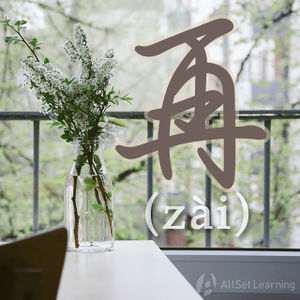Difference between revisions of "Sequencing with "xian" and "zai""
| Line 43: | Line 43: | ||
<div class="liju"> | <div class="liju"> | ||
| − | *<em>先</em> 吃饭 <em> | + | *<em>先</em> 吃饭 <em>再 说</em> 。<span class="pinyin"><em>Xiān</em> chīfàn <em>zài shuō</em>.</span><span class="trans">Let's eat first, then we'll talk.</span> |
*<em>先</em> 休息 一下 <em>再说</em> 。<span class="pinyin"><em>Xiān</em> xiūxi yīxià <em>zàishuō</em>.</span><span class="trans">Let's rest a little first, then talk.</span> | *<em>先</em> 休息 一下 <em>再说</em> 。<span class="pinyin"><em>Xiān</em> xiūxi yīxià <em>zàishuō</em>.</span><span class="trans">Let's rest a little first, then talk.</span> | ||
*你 <em>先</em> 看 完<em>再说</em> 。<span class="pinyin">Nǐ <em>xiān</em> kàn wán <em>zàishuō</em>.</span><span class="trans">Finish reading first, and then we can talk.</span> | *你 <em>先</em> 看 完<em>再说</em> 。<span class="pinyin">Nǐ <em>xiān</em> kàn wán <em>zàishuō</em>.</span><span class="trans">Finish reading first, and then we can talk.</span> | ||
Revision as of 09:03, 15 October 2018
-
Level
-
Similar to
-
Used for
-
Keywords
The word 再 (zài) actually has a lot of uses, beyond just "again." 先⋯⋯,再⋯⋯ (xiān..., zài...) is a pattern used for sequencing events, much like "First..., then..." in English. This pattern can also include 然后 (ránhòu) meaning "and after that."
Contents
Basic Usage
In the pattern below, 再 has a meaning of "then" or "and then."
Structure
先 ⋯⋯ ,再 ⋯⋯
Examples
- 先 洗 手 再 吃。Wash your hands first, and then eat.
- 我 喜欢 先 洗澡 ,再 睡觉。I prefer to take a bath before I go to bed.
- 请 你 先 买 票 再 进。Please buy a ticket before you enter.
- 你 要 先 做 作业 ,再 看 电视。First you need to do your homework, and then you can watch TV.
- 我 想 先 找 工作 ,再 搬家 。I want to find a job first, and then move to a new place.
Colloquial Usage with 再说
You may have learned that 再说 can mean "in addition." Well, this usage of 再 is a more literal combination of 再说, fitting into the 先⋯⋯再⋯⋯ pattern.
So in this usage, 再说 doesn't really mean "in addition." Rather, it most literally means "and then we'll talk." In other words, "let's just do this now," and then after we see the result, we can talk some more about next steps. There's kind of a "let's see how this goes first" feeling to the expression.
Structure
Note that in the pattern below, the sentence normally ends with 再说.
先 + [Verb Phrase] + 再说
Examples
- 先 吃饭 再 说 。Let's eat first, then we'll talk.
- 先 休息 一下 再说 。Let's rest a little first, then talk.
- 你 先 看 完再说 。Finish reading first, and then we can talk.
- 我 先 问 一下 老板 再说 。I'm going to ask the boss first.
- 你们 先 讨论 一下 再说 。You guys discuss a little first, then we'll talk.
"and then..." with 接着
When describing a series of actions, steps, or consecutive events, your Chinese will sound more natural if you can diversify your conjunctions. 然后 (ránhòu) is most commonly used, a conjunction which means "and then." Alternatively, you can use 接着 (jīezhe), as a conjunction that means "next," or "afterwards."
A longer example to help you understand how they can all work together:
- 今 早 我 起床 以后 先 准备 早饭 ,再 叫 孩子们 起床 ,接着 我们 一起 吃早饭 ,然后 我 送 他们 去 学校 。After I got up this morning, I first prepared breakfast, and then I woke up the kids. Afterwards, we ate breakfast together. After that, I took them to school.
Sources and further reading
Books
- Integrated Chinese: Level 1, Part 1 (3rd ed) (pp. 258-9) Anything Goes (无所不谈) →buy
- Integrated Chinese: Level 2, Part 2 (pp. 19-20) Anything Goes (无所不谈) →buy
- 卓越汉语-公司实战篇 (pp. 172) 卓越汉语-公司实战篇 →buy



